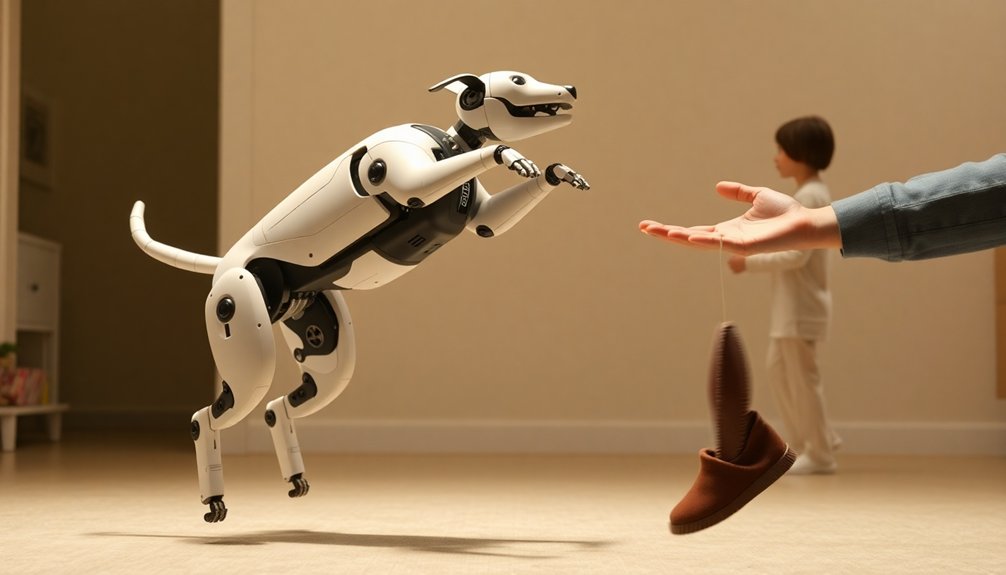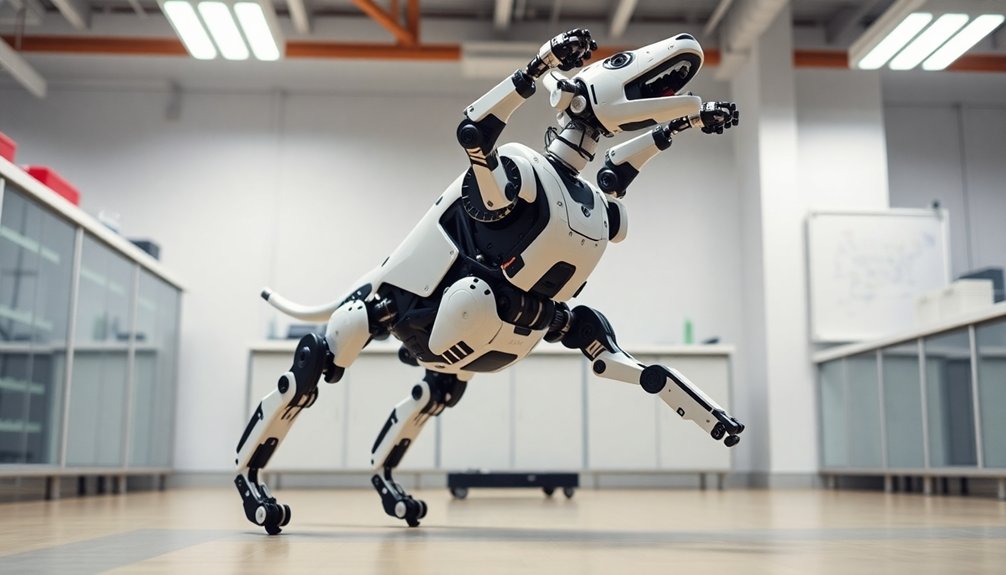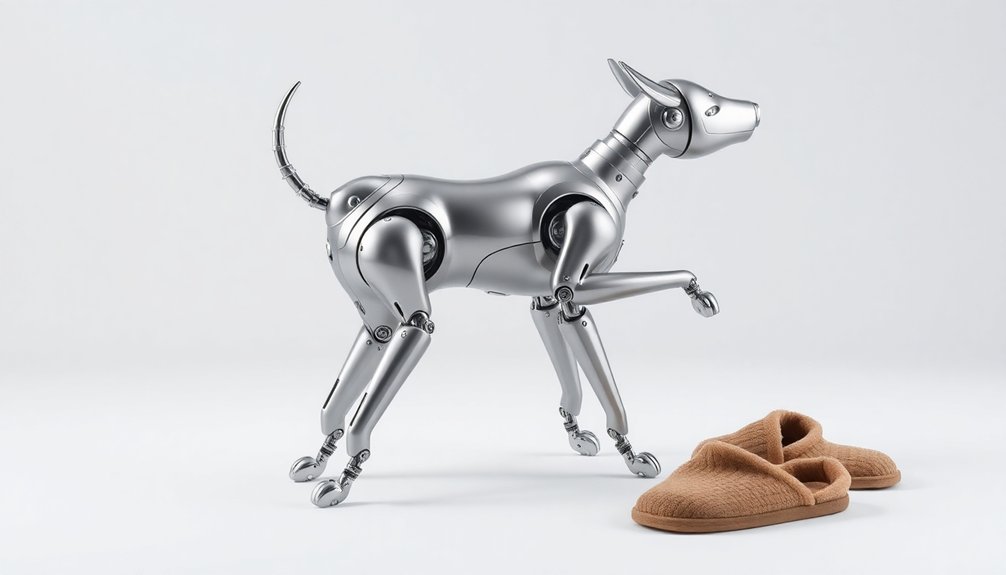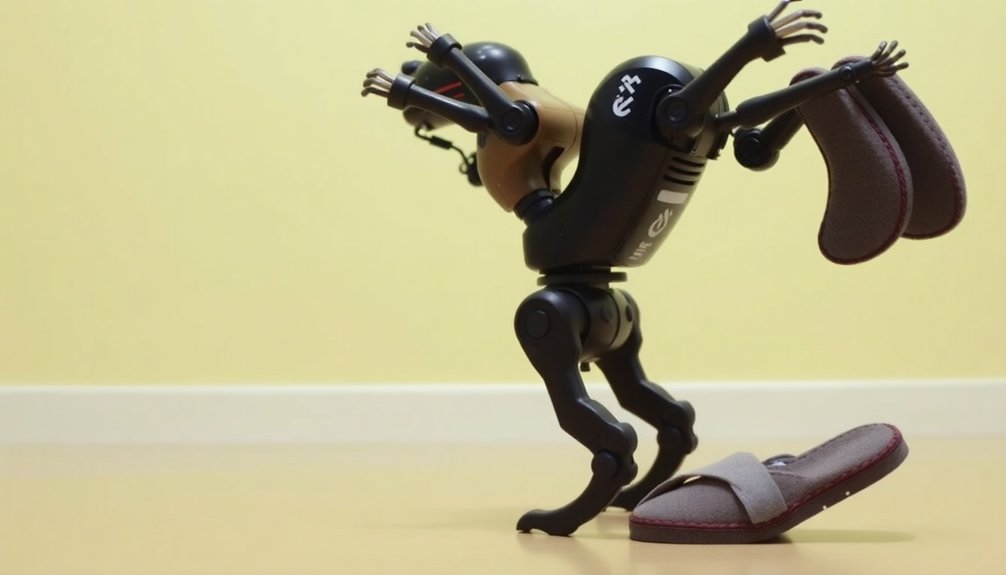Table of Contents
Robot dogs are engineering marvels that can backflip like Olympic gymnasts but can’t handle basic household tasks. They’re basically super-smart toddlers: incredible at complex calculations yet utterly useless at fetching slippers. Their lightweight frames and performance-driven designs mean they’ll nail a parkour routine but struggle to grab your morning newspaper. Curious about how these high-tech canines might—or might not—revolutionize our homes? Stick around.
Backflips vs. Basic Household Retrieval

Ever wondered why a robot dog can nail a perfect backflip but can’t fetch your slippers? Welcome to the wild world of robotic limitations.
These agile machines might look impressive twirling through the air, but their retrieval skills are basically nonexistent. It’s all about design priorities. The MIT Mini Cheetah and Bittle robots are engineered for jaw-dropping acrobatics, not mundane household tasks.
Their complex algorithms can manage precision flips, but picking up a slipper? Not a chance. Mechanical precision drives their advanced sensor and movement capabilities, prioritizing dynamic motion over static object manipulation. Their lightweight frames and advanced sensors are optimized for movement, not manipulation.
Robotic retrieval requires entirely different mechanical skills – like specialized grippers and object recognition that these backflip champions simply don’t possess. The Bittle X actually supports IoT and AI capabilities that could potentially enhance future interaction and task performance.
Cool tricks? Absolutely. Helpful household companions? Not quite yet.
High-Tech Gymnastics, Low-Tech Helpfulness
Sure, robot dogs can do backflips that would make an Olympic gymnast jealous, but can they fetch your slippers or grab a cold drink from the fridge? With the AI robot dog market expected to reach USD 2.46 billion by 2033, we’re looking at these high-tech canines that can navigate mountain terrain and perform jaw-dropping aerial stunts, yet they’re mysteriously stumped by basic household tasks that a five-year-old with opposable thumbs could manage. It’s like having a Ferrari that can’t parallel park – technically impressive, but not exactly practical for most of us just hoping for a robotic helper that won’t turn our living room into an obstacle course. Moreover, key market drivers like the growing aging population and increasing acceptance of robots suggest these technological marvels might one day bridge the gap between impressive acrobatics and practical assistance. Advanced companion technologies are emerging that could potentially enhance the collaborative potential between humans and robotic assistants, offering hope for more versatile and helpful robotic companions in the future.
Robot Cool Moves
While robots might look like they’re just showing off with their gymnastic prowess, they’re actually revealing something fascinating about the future of technology. Our robot friends are mastering incredible moves like backflips and parkour stunts, but can’t quite handle everyday tasks. Take Atlas, the poster child of robot agility, who can nail complex gymnastic routines with 80% precision yet struggles to grab a cup of coffee. Robotic sensory limitations mean that despite complex movement capabilities, precise environmental interaction remains a significant challenge for mechanical systems. The current parkour demonstrations by Atlas highlight the complex robotic movement algorithms that enable sophisticated physical performance while still being far from practical utility. Sensor fusion technologies are gradually improving robotic perception, allowing machines to integrate visual, tactile, and motion data for more nuanced environmental understanding.
| Robot Skill | Cool Factor | Practical Use |
|---|---|---|
| Backflips | High | Low |
| Vaulting | Epic | Minimal |
| Leaping | Awesome | None |
| Dancing | Impressive | Zilch |
We’re watching technology that’s more circus performer than household helper. Who knew the future would be so athletically talented yet domestically challenged?
Home Help Lacking
So, our robot friends can backflip like Olympic gymnasts but can’t pour a glass of water? Welcome to the frustrating world of smart home technology, where impressive tricks don’t translate to actual helpfulness. Smart home device adoption has actually declined from an average of 8 to 6.2 devices per household, highlighting the growing consumer skepticism. Annual Consumer Survey reveals that despite significant research investments, only 500 consumers were studied in key markets, indicating limited insights into technological gaps. Robotic workforce limitations show that current AI technologies struggle to bridge the gap between advanced capabilities and practical utility.
Our user experience reveals a stark reality: these high-tech companions are more circus performers than household assistants. Despite incredible AI advancements, most smart devices struggle with basic tasks.
They’ll happily optimize energy consumption or run complex security protocols, but ask them to fetch your slippers? Good luck. The gap between technological capability and practical utility remains wide.
We’re investing in machines that can execute perfect aerial maneuvers yet can’t handle simple household chores. It’s like having a PhD-level mathematician who can’t tie their own shoes.
Innovation, meet reality check.
Precision Engineering, Impractical Performance

Despite engineering marvels that make robot dogs look like sci-fi miracles, these mechanical canines are still painfully awkward at most real-world tasks.
We’ve cracked precision challenges in creating machines that can backflip, but ask them to fetch a simple newspaper? Total fail.
The engineering limitations are stark: advanced materials and sophisticated actuators let these robots perform incredible stunts, but they can’t navigate a living room without bumping into furniture. Sensor fusion techniques can help improve their environmental perception and navigation capabilities.
Their specialized design means they’re more likely to explore hazardous environments than cuddle on your couch. Multi-link tail systems could potentially improve their navigation and stability, offering a more adaptable robotic platform.
Weight distribution and high-tech sensors enable complex movements, but basic domestic utility? Not happening.
These robot dogs are basically extremely expensive, incredibly complex performance artists with zero household skills. The military surveillance capabilities demonstrate their true purpose as precision technological tools rather than household companions.
Extreme Mobility, Zero Domesticity
We’ve got robot dogs that can dance through disaster zones and military checkpoints, but can’t fetch a simple newspaper from the driveway—isn’t that peak technological irony? The Unitube B2, for instance, can cross 40cm high platforms and run at 6m/s, terrain-conquering capability yet remains hilariously unsuited for home pet duties. These high-tech quadrupeds are engineering marvels designed for extreme environments, boasting capabilities that make your average Roomba look like a toddler’s toy. Their performance is jaw-dropping but utterly impractical for daily life: we’re talking about machines that can navigate burning buildings and survive combat zones, yet struggle with the basic domestic challenge of not knocking over a coffee table.
Agile, Not Practical
While quadruped robots might look like the coolest science fiction come to life, they’re basically high-performance athletes with zero domestic skills.
These agile limitations mean our fancy robot dogs can leap and backflip, but good luck getting them to fetch your morning newspaper. Industrial applications reign supreme – these machines are built for complex manufacturing tasks, not for cuddling or household chores.
Sure, they can navigate treacherous terrain and dodge obstacles at lightning speed, but try asking them to bring you a beer? Not happening.
The Stanford Doggo and its robotic cousins are pure research machines: impressive technological marvels that showcase incredible mobility, yet about as useful in a home as a rocket-powered skateboard.
Practical? Hardly. Cool? Absolutely.
Performance Over Utility
If agility were an Olympic sport, robot dogs would take home the gold every single time.
These mechanical marvels prioritize performance metrics over practical utility, showcasing skills that are more about showing off than being helpful.
Consider their ridiculous capabilities:
- Backflips that would make human gymnasts jealous
- Leaping gaps wider than their own body length
- Squeezing through spaces no reasonable creature should fit
We’ve created machines that can climb obstacles and detect thermal anomalies, but can’t perform basic household tasks.
Their mobility is mind-blowing, yet utterly impractical.
The utility trade-offs are hilarious — a robot that can navigate treacherous terrain but can’t fetch a newspaper?
Talk about overengineering.
These aren’t companions; they’re athletic demonstrations of pure technological flex.
High-Tech, Low-Touch
Despite their jaw-dropping mobility, robot dogs remain the ultimate technological cocktease — all performance, zero practicality.
These high-tech canines can leap, spin, and backflip with mind-blowing precision, but ask them to fetch a newspaper? Total fail.
We’re looking at machines designed for extreme environments and industrial tasks, not your living room. Their robot functionality screams “specialized mission” rather than “household integration.”
Unitree’s robots showcase insane navigation skills and sensor technologies that would make NASA engineers drool, but try getting one to make your bed? Not happening.
They’re built for disaster response, advanced manufacturing, and looking cool at tech conferences — basically the supermodels of the robotics world.
Impressive? Absolutely. Useful at home? Not even close.
Advanced Robotics, Simple Task Failure
Ever wondered why robots can nail a backflip but struggle to grab a pair of slippers? We’ve got the scoop on robot capabilities that’ll blow your mind.
Our mechanical friends are brilliant at some tasks, but hilariously terrible at others. Here’s why:
- Specialized skills don’t translate to everyday tasks
- Complex environments confuse robotic sensors
- Simple human actions require insane perceptual complexity
Moravec’s Paradox reveals a wild truth: robots can navigate Mars but can’t reliably pick up a coffee mug.
Their task efficiency nosedives when confronted with unpredictable, unstructured home environments. It’s like having a genius who can solve quantum physics but can’t tie shoelaces.
We’re inching closer to genuinely adaptable robots, but right now? They’re basically super-smart toddlers with incredible mechanical muscles — impressive, yet hilariously limited.
Technical Marvels, Everyday Incompetence

Those mechanical marvels that can calculate rocket trajectories? They’re hilariously hopeless at basic household tasks. Our robot innovation has reached wild heights, yet these sophisticated machines can’t seem to master simple chores.
| Technical Capabilities | Everyday Performance |
|---|---|
| Complex Calculations | Making Coffee |
| Precise Movements | Finding Lost Keys |
| Advanced Sensors | Folding Laundry |
We’ve created robots that perform incredible feats of task efficiency, but ask them to grab your slippers and they’ll probably short-circuit. They can execute perfect backflips, navigate treacherous terrain, and solve mathematical equations—but hand them a broom? Total disaster. It’s like designing a supercomputer that can’t open a jar of pickles. Our robotic friends are brilliant specialists trapped in a world that demands generalists, perpetually caught between technological wonder and everyday incompetence.
Spectacular Stunts, Mundane Limitations
When robot dogs first burst onto the scene, we couldn’t help but marvel at their jaw-dropping acrobatics—backflips that would make Olympic gymnasts look clumsy, terrain navigation that seemed straight out of a sci-fi movie.
But here’s the hilarious twist: these mechanical marvels of robot agility fall flat when it comes to task efficiency. Consider their spectacular yet limited capabilities:
- They can flip through the air with stunning precision
- They navigate complex terrain like parkour pros
- They utterly fail at basic household tasks
Sure, they’ll nail a backflip faster than you can blink, but ask them to fetch your slippers? Forget it.
These robot dogs are more likely to short-circuit than successfully retrieve anything. They’re fundamentally high-tech gymnasts with zero practical skills—impressive, yet frustratingly useless in everyday life.
Robot Acrobatics, Domestic Dysfunction

While robot dogs might look like the ultimate sci-fi dream machine, their domestic performance is more comedy of errors than cutting-edge convenience.
Sure, these mechanical mutts can launch themselves into mind-blowing backflips and jump nearly four feet high, but can they bring you a newspaper or cuddle when you’re feeling down?
Their robotic dexterity means precise motor control—8,000 calculations per second—but zero emotional connection.
We’re talking about machines that navigate complex terrains but struggle with basic home interactions.
Open-source programming means they’re technically impressive, yet practically limited.
They’ll patrol your home with laser-sharp sensors but can’t replace the warm, unpredictable companionship of a real furry friend.
Robot dogs: more impressive in the lab than in your living room.
People Also Ask
Can Atlas Really Do a Perfect Backflip but Can’t Pick up a Pair of Slippers?
We’re showcasing incredible robot agility through backflips while facing task limitations that prevent precise object manipulation like picking up small items such as slippers.
Why Are Robots so Good at Complex Movements but Terrible at Simple Tasks?
Powerful, precise programming propels our robots through complex choreographies, yet their limited robot dexterity stumbles on simple task complexity, revealing the intricate challenge of mimicking human-like manipulation and environmental adaptation.
How Much Does an Advanced Robot Like This Actually Cost?
We’ve found that advanced robot dog pricing ranges from $1,600 to $3,000, depending on complex technology like AI processors, sophisticated sensors, and mobility capabilities that drive up manufacturing costs.
Are These Robots Just for Show or Do They Have Practical Applications?
We’re not just showcasing circus tricks; these robot dogs revolutionize practical robotics, delivering critical functionality across security, industrial maintenance, and healthcare—far beyond mere entertainment spectacles.
Will Future Robots Be Able to Both Do Backflips and Help Around the House?
We’re seeing promising robot capabilities that hint at future potential, where agile machines will seamlessly blend acrobatic movements with practical household assistance through advanced AI and adaptive design.
The Bottom Line
We’ve seen robots leap and spin like Olympic gymnasts, but ask them to grab your coffee mug? Total fail. It’s like building a Ferrari that can’t drive through a parking lot. Our robotic friends are incredible technological marvels, but right now they’re fancy show ponies with zero practical skills. The future isn’t about acrobatics—it’s about making technology that actually helps us in everyday life. We’re getting there, slowly but surely.
References
- https://bostondynamics.com/blog/leaps-bounds-and-backflips/
- https://bostondynamics.com/atlas/
- https://www.techbriefs.com/component/content/article/31826-atlas-robot-can-now-backflip-it
- https://www.yankodesign.com/2024/12/04/this-236-robot-dog-obeys-voice-commands-does-backflips-and-even-supports-chatgpt-integration/
- https://www.businessresearchinsights.com/market-reports/ai-robot-dog-market-118006
- https://www.globenewswire.com/news-release/2024/12/04/2991514/0/en/AI-Robot-Dog-Market-is-Anticipated-to-Grow-at-a-CAGR-of-7-3-Reaching-a-Valuation-of-USD-2-664-16-million-by-2034-PMR.html
- https://www.technavio.com/report/robotic-pet-dogs-market-industry-size-analysis
- https://www.datainsightsmarket.com/reports/combat-robot-dogs-632944
- https://blog.utc.edu/news/2025/03/paws-and-effect-utc-mechatronics-team-training-robot-dogs-to-move-like-canines/
- https://www.ynetnews.com/business/article/b12cc1nk0
